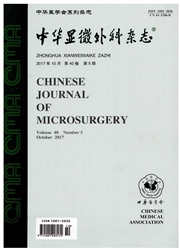

 中文摘要:
中文摘要:
目的 探讨静脉改形联合微血管吻合器在头颈部缺损重建口径不等血管吻合中的应用价值.方法 2013年10月-2014年9月对头颈部缺损游离组织瓣修复重建患者共计66条具有显著口径差异的静脉进行端端吻合,其中40条静脉分别经侧方切开、Y-T扩大及楔形缩口3种方法改形后使用微血管吻合器进行吻合(吻合器组),其余26条静脉在显微镜下行传统手工缝合(手缝组).记录所吻合静脉的直径、吻合时间、术后血管危象、组织瓣成活以及吻合器相关并发症的发生情况. 结果 采用静脉改形联合微血管吻合器进行不等口径静脉的端端吻合,用时分别为(4.78±1.14) min(侧方切开)、(5.16±2.07) min(Y-T扩大)和(11.09±3.21)min(楔形缩口),均显著低于手缝组(25.08±5.51) min,差异有统计学意义(P<0.05).手缝组术中2条静脉吻合口血流不通畅,剪去原吻合口后重新吻合;1例皮瓣术后72 h静脉危象,改行胸大肌皮瓣修复.吻合器组所有静脉均一次吻合成功,无吻合口漏血、管壁撕裂及吻合器脱落等情况发生;1例患者术后5h颈部血肿,清除血肿后组织瓣血运未受影响.所有患者术后随访6~ 18个月,组织瓣愈合良好,未见明显手术并发症及吻合器排斥反应. 结论 利用微血管吻合器进行口径不等静脉的端端吻合时,侧方切开、Y-T扩大及楔形缩口3种静脉改形方法能显著缩小口径差异,提高血管吻合速度,降低吻合难度,吻合质量可靠.特别是当使用颈外静脉作为受区静脉时,采用楔形缩口的改形方法既能充分发挥其血流动力学优势,又不会发生因吻合口缩窄而导致的静脉回流受阻,是头颈部缺损重建较为适宜的血管成形方法.
 英文摘要:
英文摘要:
Objective To assess the clinical application value of phleboplasties combined with microvascular anastomotic device in venous anastomosis with diameter discrepancy in head and neck defects reconstruction.Methods Sixty-six pairs of veins with significant diameter discrepancy were anastomosed in head and neck reconstructive surgeries with free flaps.Forty of them were anastomosed with microvascular anastomotic device (the coupler group) after phleboplasties including lateral incision, Y-T enlargement and wedge excision while the other 26 pairs of veins were conventionally sutured (the sutured group).Diameter of each vein, anastomosis time, post-operative vascular crisis, flap survival and complications related to the microvascular anastomotic device were recorded.Results The average anastomosis time of the coupler group was (4.78 ± 1.14) min for lateral incision, (5.16 ± 2.07) min for Y-T enlargement and (11.09 ± 3.21) min for wedge excision, and all of them were significantly shorter than that of the sutured group.In the sutured group, all flaps survived except for 2 veins with poor blood flow were cut and re-anastomosed during the operation;1 flap with venous crisis within 72 hours after the operations was explored and replaced with the pectoralis major myocutaneous flap.All veins in the coupler group were successfully anastomosed in a single coupling procedure without anastomotic impatency, blood leak, vessel tearing and ring shedding.No vascular crisis occurred postoperatively.One patient underwent cervical haematoma 5 hours after the operation, and the flap blood supply was unaffected after the haematoma was removed.All flaps in the coupler group survived completely.Patients in both two groups were followed up 6 to 18 months.All flaps healed perfectly and no obvious surgical complications or microvascular anastomotic device rejection happened.Conclusion When anastomoses are carried out using microvascular anastomotic device between veins of different size, phleboplasties including latera
 同期刊论文项目
同期刊论文项目
 同项目期刊论文
同项目期刊论文
 期刊信息
期刊信息
